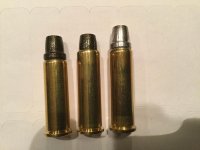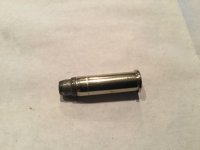38SPL HV
Well-known member
In the past, I loaded the Lyman 358429 in 357 Magnum cases over the front driver band to accommodate the “shorter” S&W Mod 28 cylinders. Never cared too much doing this...the OAL varied because of the roll crimp “pushing” the projectile slightly further into the case. I did chronograph the “over the shoulder” load with 11.0 grs 2400 and hit over 1,130 FPS in my Ruger 4 5/8 inch BH...the OAL was 1.540 as opposed to the 1.553 recommended by Lyman (crimping over the shoulder pushed the 358429 down from the suggested OAL 1.553 to 1.540).
I’ve since been loading the 358429 and crimping them in the crimp groove with 12.0 grs of 2400...they fit in the longer Ruger BH (New Model) cylinder (my S&W Model 28’s are long departed hopefully making their current owners very happy). Good and very accurate load and I intend to chronograph them in a couple of weeks when time allows.
Yes, Keith made the 358429 for 38 Special cases, perhaps I’ll just stick with this setup. My load in 38-44 with the 358429 uses 11.0 grs 2400...a very accurate and true 38-44 load, but for use ONLY in 357 Magnum or S&W Heavy Duty/Outdoorsman heavy frame revolvers. I color the primer red with a marker and put them in boxes marked “38-44 - USE ONLY in Ruger Blackhawk 357 Magnum”
Appreciate any of your experiences with the 358429 in 38-44 and 357 Magnums.
(Sorry if I’m constantly posting about 38/357 loads, they are the only revolvers I have. I did have 41 and 44 Magnums in the past but when you get a little “long in the tooth” as I, you like to throttle things down a bit to still enjoy this great pastime...thank you for your patience).
Here are pics of 358429 in 38-44 and 357 Mag (short and long) configurations.
I’ve since been loading the 358429 and crimping them in the crimp groove with 12.0 grs of 2400...they fit in the longer Ruger BH (New Model) cylinder (my S&W Model 28’s are long departed hopefully making their current owners very happy). Good and very accurate load and I intend to chronograph them in a couple of weeks when time allows.
Yes, Keith made the 358429 for 38 Special cases, perhaps I’ll just stick with this setup. My load in 38-44 with the 358429 uses 11.0 grs 2400...a very accurate and true 38-44 load, but for use ONLY in 357 Magnum or S&W Heavy Duty/Outdoorsman heavy frame revolvers. I color the primer red with a marker and put them in boxes marked “38-44 - USE ONLY in Ruger Blackhawk 357 Magnum”
Appreciate any of your experiences with the 358429 in 38-44 and 357 Magnums.
(Sorry if I’m constantly posting about 38/357 loads, they are the only revolvers I have. I did have 41 and 44 Magnums in the past but when you get a little “long in the tooth” as I, you like to throttle things down a bit to still enjoy this great pastime...thank you for your patience).
Here are pics of 358429 in 38-44 and 357 Mag (short and long) configurations.
Attachments
Last edited:



